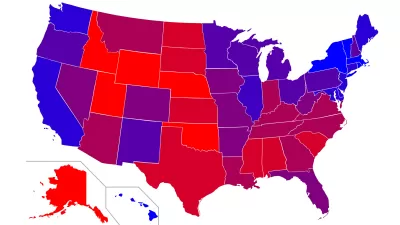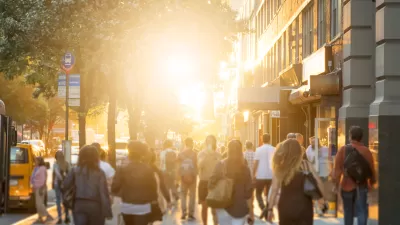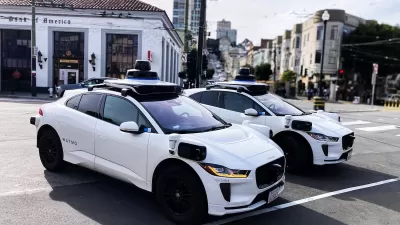Some presidential candidates favor sprawl, but a surprising number live in cities or inner-ring suburbs.

Since presidential candidates tend to be wealthy, middle-aged heads of households, and wealthy middle-aged families tend to live in sprawl, one might think that most Republican presidential candidates live in sprawl. I was able to find out where most (though not all) candidates live—and although it is true that most of them live in sprawl, this rule has some interesting exceptions.
To be sure, Republican front-runner Ben Carson unquestionably lives in sprawl. He lives in Upperco, a Baltimore outer suburb about 30 miles from downtown. Some parts of Upperco have a Walkscore of 0, and a look at Upperco on Google Street View reveals that streets are few and far between. Every house is very far from everything else. Another religious conservative, Rick Santorum, lives in a five-acre house with a 0 Walkscore in Great Falls, a wealthy outer suburb of Washington
Another favorite of religious conservatives, former Arkansas governor Mike Huckabee, has left his home state and moved to a beachfront mansion in resort-oriented Walton County, Florida. Although Huckabee's new home is only a few miles from new urbanist favorite Seaside, its Walkscore is 14.* Although the Huckabee manse seems to be in the middle of nowhere, he can walk half a mile to get a meal or a cup of coffee, if he doesn't mind the absence of sidewalks. Just as Gov. Huckabee's policies occasionally deviate from solid conservatism, his home isn't quite 100 percent sprawl.
On the other hand, Florida's two candidates favor inner ring suburbs. Jeb Bush lives in a townhouse in downtown Coral Gables, about five miles from downtown Miami. Coral Gables is a older inner-ring suburb with a highly walkable commercial district (the Miracle Mile area) and satisfactory bus service. Bush's street has a Walkscore of 77. Marco Rubio has spent most of his life in West Miami, a more working-class suburb just west of Coral Gables. Rubio's former West Miami home has a Walkscore of 80, and he lived only five blocks south of the 8 bus, which runs about every 10 or 15 minutes during the day and until 11 pm at night—pretty good by the low standards of Florida. On the negative side, S.W. 8th Street, the nearest commercial street, is a four-lane stroad. (A couple of years ago, Rubio sold the house to move his permanent residence to Washington; I was unable to find out where he lives in Washington.)
Tea Party favorite Ted Cruz prefers urban life. Cruz lives in a condo (Walkscore 75) in River Oaks, Houston's in-town, old money neighborhood. Cruz lives two miles from City Hall, a couple of blocks from numerous bus routes, and 0.3 miles from Whole Foods. On the negative side, the Whole Foods is on a stroad, as one might expect given Houston's reputation for car-oriented design.
Although governors generally live in governor's mansions, Ohio's John Kasich is an exception. He lives in a wooded area in Genoa Township, an outer suburb about 20 miles north of Columbus with a single-digit Walkscore. Similarly, New Jersey's Chris Christie lives in Mendham Township, NJ, a large-lot exurb with a Walkscore of 11. By contrast, Bobby Jindal lives in Louisiana's governor's mansion just north of downtown Baton Rouge.
Our two tycoon candidates favor very different environments. Carly Fiorina lives in a gated community about 25 miles south of Washington, in an area that (based on my look at the area on Street View) would probably have a negative Walkscore if such a thing were possible. On the other hand, Donald Trump has numerous residences, but one of them is just steps from Central Park.
In sum, it appears that the majority of Republican candidates do live in sprawl—but the exceptions are not necessarily the candidates I would have expected. The candidates with the most urban addresses are not always the most moderate.
At this point, you might be saying "So what? Does any of this trivia have any broader lessons?" Actually, yes. The one thing I noticed is that every single candidate either favors a highly walkable area (Walkscore 75+) or in an extremely car dependent area (Walkscore 15 or below). Not one of the candidates, as far as I can tell,** lives in the in-between areas (Walkscore 20-75) where most Americans live. If the Republican candidates reflect upper-class Americans generally, this tells us something about American tastes—or at least about the tastes of a certain slice of middle-aged, well-heeled America. Semi-walkable '50s suburbia is what Americans might be willing to settle for if they can't afford anything better—but I doubt it is really most people's "American Dream."
*In deference to the candidates' privacy, I have tried to avoid mentioning their street address even when I found it out.
**As you might have noticed some candidates are missing. I was unable to find out where Sens. Paul and Graham or Gov. Pataki live.

Study: Maui’s Plan to Convert Vacation Rentals to Long-Term Housing Could Cause Nearly $1 Billion Economic Loss
The plan would reduce visitor accommodation by 25,% resulting in 1,900 jobs lost.

North Texas Transit Leaders Tout Benefits of TOD for Growing Region
At a summit focused on transit-oriented development, policymakers discussed how North Texas’ expanded light rail system can serve as a tool for economic growth.

Using Old Oil and Gas Wells for Green Energy Storage
Penn State researchers have found that repurposing abandoned oil and gas wells for geothermal-assisted compressed-air energy storage can boost efficiency, reduce environmental risks, and support clean energy and job transitions.

Private Donations Propel Early Restoration of Palisades Playground
Los Angeles has secured over $1.3 million in private funding to restore the Pacific Palisades playground months ahead of schedule, creating a modern, accessible space that supports community healing after recent wildfires.

From Blight to Benefit: Early Results From California’s Equitable Cleanup Program
The Equitable Community Revitalization Grant (ECRG) program is reshaping brownfield redevelopment by prioritizing projects in low-income and environmental justice communities, emphasizing equity, transparency, and community benefits.

Planting Relief: Tackling Las Vegas Heat One Tree at a Time
Nevada Plants, a Las Vegas-based nonprofit, is combating the city’s extreme urban heat by giving away trees to residents in underserved neighborhoods, promoting shade, sustainability, and community health.
Urban Design for Planners 1: Software Tools
This six-course series explores essential urban design concepts using open source software and equips planners with the tools they need to participate fully in the urban design process.
Planning for Universal Design
Learn the tools for implementing Universal Design in planning regulations.
Ascent Environmental
Borough of Carlisle
Institute for Housing and Urban Development Studies (IHS)
City of Grandview
Harvard GSD Executive Education
Toledo-Lucas County Plan Commissions
Salt Lake City
NYU Wagner Graduate School of Public Service






























